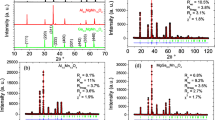Abstract
The kinetics of non-convergent cation ordering in MgFe2O4 have been studied by measuring the Curie temperature (T c) of synthetic samples as a function of isothermal annealing time. The starting material was a synthetic sample of near-stoichiometric MgFe2O4, synthesised from the oxides in air and quenched from 900 °C in water. Ordering experiments were performed using small chips of this material and annealing them at temperatures between 450 °C and 600 °C. The chips were periodically removed from the furnace, and their Curie temperatures were determined from measurements of alternating-field magnetic susceptibility (χ) as a function of temperature (T) to 400 °C. The Curie temperature of MgFe2O4 is very sensitive to the intracrystalline distribution of Fe3+ and Mg cations between tetrahedral and octahedral sites of the spinel crystal structure, and hence provides a very sensitive probe of the cation ordering process. The χ-T curve for the starting material displays a single sharp magnetic transition at a temperature of 303 °C. During isothermal annealing, the χ-T curve develops two distinct magnetic transitions; the first at a temperature corresponding to T c for the disordered starting material and the second at a higher temperature corresponding to T c for the equilibrium ordered phase. The size of the magnetic signal from the ordered phase increases smoothly as a function of time, until equilibrium is approached and the shape of the χ-T curve corresponds to a single sharp magnetic transition for the homogeneous ordered phase. These observations demonstrate that cation ordering in MgFe2O4 proceeds via a heterogeneous mechanism, involving the nucleation and growth of fine-scale domains of the ordered phase within a matrix of disordered material. Disordering experiments were performed by taking material equilibrated at 558 °C and annealing it at 695 °C. The mechanism of isothermal disordering is shown to involve nucleation and growth of disordered domains within an ordered matrix, combined with continuous disordering of the ordered matrix. This mixed mechanism of disordering may provide an explanation for the difference between the rates of ordering and disordering observed in MgFe2O4 using X-ray diffraction. The origin of the heterogeneous ordering/disordering mechanism is discussed in terms of the Ginzburg-Landau rate law. It is argued that heterogeneous mechanisms are likely to occur in kinetic experiments performed far from equilibrium, whereas a homogeneous mechanism may operate under slow equilibrium cooling. The implications of these observations for geospeedometry are discussed.
Similar content being viewed by others
Author information
Authors and Affiliations
Additional information
Received: 12 May 1998 / Accepted: 25 June 1998
Rights and permissions
About this article
Cite this article
Harrison, R., Putnis, A. Determination of the mechanism of cation ordering in magnesioferrite (MgFe2O4) from the time- and temperature-dependence of magnetic susceptibility. Phys Chem Min 26, 322–332 (1999). https://doi.org/10.1007/s002690050192
Issue Date:
DOI: https://doi.org/10.1007/s002690050192




